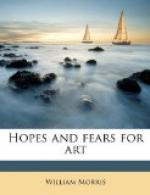Next, if you make these two shades different in tint as well as, or instead of, in depth, you have fairly got out of monochrome, and will find plenty of difficulties in getting your two tints to go well together. The putting, for instance, of a light greenish blue on a deep reddish one, turquoise on sapphire, will try all your skill. The Persians practise this feat, but not often without adding a third colour, and so getting into the next stage. In fact, this plan of relieving the pattern by shifting its tint as well as its depth, is chiefly of use in dealing with quite low-toned colours—golden browns or greys, for instance. In dealing with the more forcible ones, you will find it in general necessary to add a third colour at least, and so get into the next stage.
This is the relieving a pattern of more than one colour, but all the colours light, upon a dark ground. This is above all useful in cases where your palette is somewhat limited; say, for instance, in a figured cloth which has to be woven mechanically, and where you have but three or four colours in a line, including the ground.
You will not find this a difficult way of relieving your pattern, if you only are not too ambitious of getting the diverse superimposed colours too forcible on the one hand, so that they fly out from one another, or on the other hand too delicate, so that they run together into confusion. The excellence of this sort of work lies in a clear but soft relief of the form, in colours each beautiful in itself, and harmonious one with the other on ground whose colour is also beautiful, though unobtrusive. Hardness ruins the work, confusion of form caused by timidity of colour annoys the eye, and makes it restless, and lack of colour is felt as destroying the raison d’etre of it. So you see it taxes the designer heavily enough after all. Nevertheless I still call it the easiest way of complete pattern-designing.
I have spoken of it as the placing of a light pattern on dark ground. I should mention that in the fully developed form of the design I am thinking of there is often an impression given, of there being more than one plane in the pattern. Where the pattern is strictly on one plane, we have not reached the full development of this manner of designing, the full development of colour and form used together, but form predominant.
We are not left without examples of this kind of design at its best. The looms of Corinth, Palermo, and Lucca, in the twelfth, thirteenth, and fourteenth centuries, turned out figured silk cloths, which were so widely sought for, that you may see specimens of their work figured on fifteenth-century screens in East Anglian churches, or the background of pictures by the Van Eycks, while one of the most important collections of the actual goods is preserved in the treasury of the Mary Church at Dantzig; the South Kensington Museum has also a very fine collection of these, which I can’t help thinking are not quite as visible to the public as they should be. They are, however, discoverable by the help of Dr. Rock’s excellent catalogue published by the department, and I hope will, as the Museum gains space, be more easy to see.




